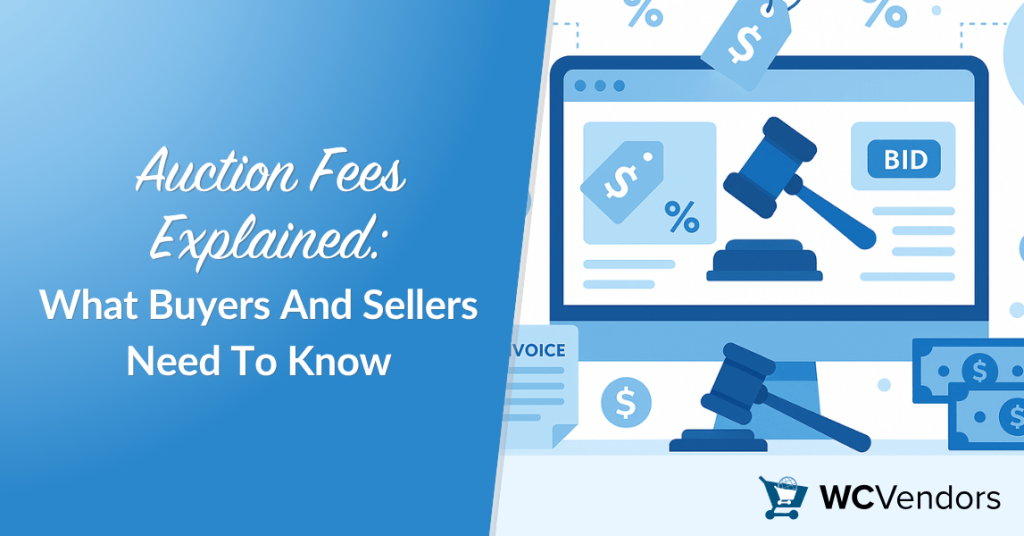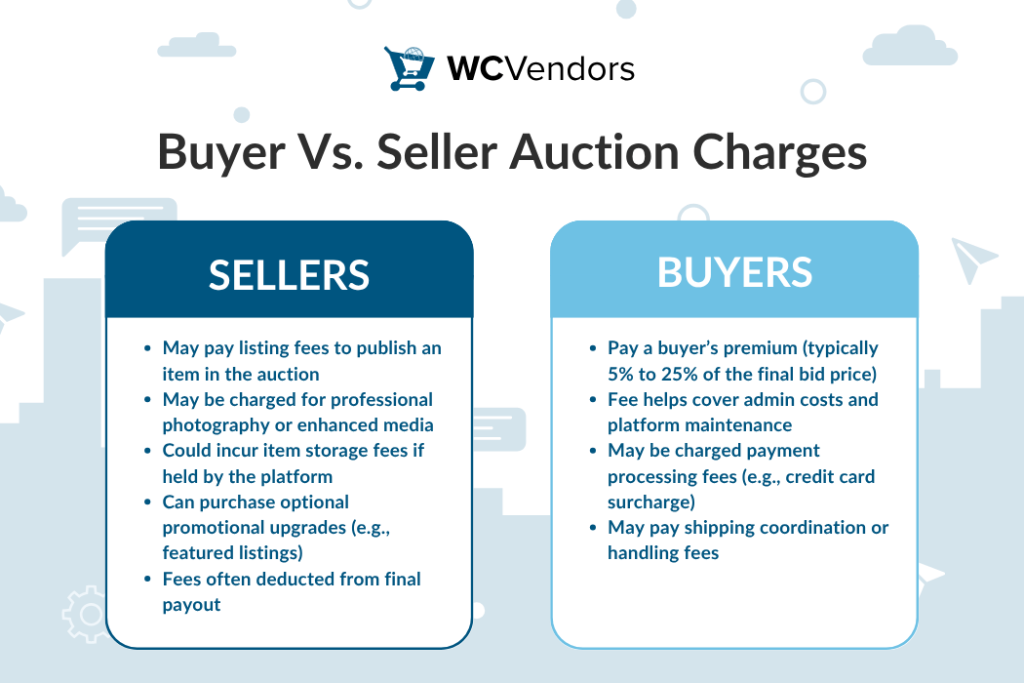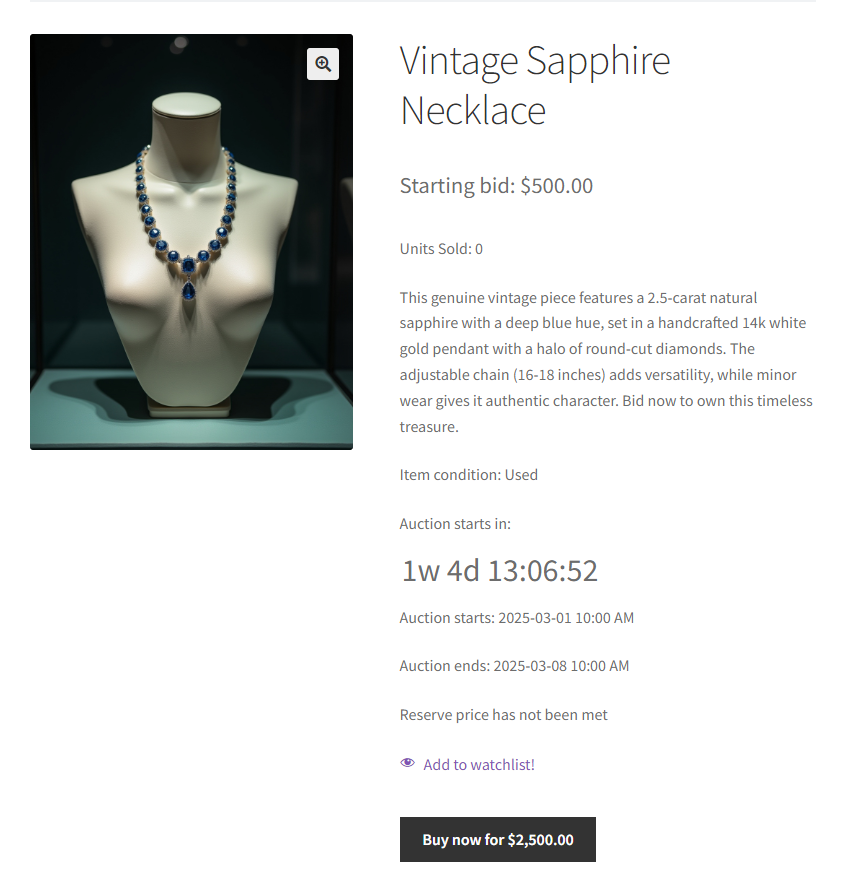
Auction fees can significantly impact how much buyers pay and how much sellers keep after the sale. Whether you’re using a traditional auction house or a WordPress multi vendor marketplace, it’s important to understand where these costs come from and how they’re calculated.
These fees often vary by platform, product type, and sales volume. Some charges are flat-rate, while others are tied to the final auction price. For sellers, auction fees affect profit margins. For buyers, they shape the total cost of acquisition.
This guide explains the different types of auction charges and why they exist. It also covers how vendors and marketplace owners can set them up fairly using a WooCommerce multi vendor marketplace with plugins like WC Vendors and Simple Auctions.
What Are Auction Fees?
Auction fees are the costs associated with selling or buying through an auction. The platform typically deducts these fees from the final sale or adds them to the winning bid.
These fees cover services like marketing, payment processing, platform usage, and vendor support. Similarly, in a WooCommerce marketplace plugin environment, these principles apply and can be customized by the admin or platform owner.
Buyer Vs. Seller Auction Charges
Both sides of an auction are charged fees, though the structure and purpose of those fees often differ.
Buyers typically pay a “buyer’s premium” by adding a percentage to the final auction price. This fee helps cover administrative costs and platform maintenance.
The rate can vary widely—from 5% to 25%—depending on the auction house, product type, or platform policies. Some platforms also charge buyers for payment processing or shipping coordination, which adds to the total cost.
Sellers, on the other hand, may be responsible for listing fees, professional photography, item storage, or optional promotional upgrades. These costs are often deducted from the final payout.
In a WordPress multi vendor marketplace, you can choose to tie these seller fees to vendor membership levels or assign them based on product categories.
In the next section, we’ll look at how traditional and online auction houses structure their action fees, so you can better understand how to compare or design your own fee model.
What Auction Houses Typically Charge
Auction houses use various fee structures. Here’s what’s commonly included:
- Seller’s commission: A cut of the final sale, usually 10–20%
- Buyer’s premium: An additional fee paid on top of the winning bid
- Listing and marketing costs: Flat fees for catalog inclusion, photography, or digital advertising
- Storage and handling: If physical items are stored before pickup
Online platforms often mirror this system, but WooCommerce marketplace plugin setups let owners simplify or automate these charges based on vendor role or product.
How Auction Price Affects Final Fees
The final sale price of an item often changes how much the seller pays in fees.
Many auction platforms use a sliding commission model. This means:
- Lower-priced items are charged a higher percentage
- Higher-priced items are charged a lower percentage
Example:
- $5,000 item → 12% commission ($600 fee)
- $20,000 item → 8% commission ($1,600 fee)
This approach rewards high-value sellers and keeps the platform competitive.
If you’re using a WooCommerce multi vendor marketplace, you can set this up with:
- Tiered commission rules in WC Vendors
- Membership-based pricing (e.g., Gold members pay less commission)
This lets you scale your auction fees fairly across different price ranges.
Common Commission Fees And Hidden Costs

Commission fees are the most visible and expected part of auction pricing. The seller usually pays these as a percentage of the final sale to the platform or auction house. However, there are often other charges that aren’t as obvious up front.
These hidden auction fees can add up quickly and affect the final payout:
- Relisting charges: If an item doesn’t sell the first time, some platforms charge a fee to relist it in a future auction.
- Media upgrades: Vendors may pay extra for professional images, video previews, or enhanced product descriptions to help their listings stand out.
- Shipping coordination: If the platform offers help arranging delivery or pickup, it may come with a handling fee or service charge.
- Payment processing fees: Credit card or online payment services usually take a 2% to 3% cut from the final amount, and the platform may choose to pass this on to the vendor.
For marketplace owners using a WordPress marketplace plugin, the good news is you can decide how these costs are handled. You might absorb some of them into your pricing structure, charge vendors directly, or offer them as optional upgrades.
This flexibility allows you to keep your platform transparent and vendor-friendly, while still covering your operational expenses.
Do Auction Fees Vary By Industry?
Yes. Real estate auctions, in particular, often have different fee models due to legal and regulatory considerations.
A real estate auction might involve:
- Seller-paid marketing packages
- Flat-rate entry fees
- Government filing or inspection costs
- Buyer’s premiums that include closing coordination
In contrast, auctions for digital goods or collectibles might only require a listing fee and a small seller commission. This flexibility is one of the reasons many are choosing to build auction websites using a WooCommerce marketplace plugin that allows category-based pricing.
Creating A Fair Fee Structure On Your Vendor Platform

Marketplace owners need to balance platform revenue with vendor satisfaction. Transparency helps retain sellers, while flexible fee rules support a wider range of vendor types.
A WordPress multi vendor marketplace setup lets you create different vendor levels and assign commission rules based on product type, vendor role, or auction performance. This ensures every seller knows what to expect and what they’re paying for.
For example, you could set up a three-tier vendor structure:
- Basic Vendors: 15% commission on the final auction price
- Pro Vendors: 10% commission, plus a $5 listing fee per item
- Gold Vendors: 7% commission, no listing fees, but only available by subscription
If a Gold vendor sells an item for $1,000 at auction, they would only pay $70 in platform fees. Meanwhile, a Basic vendor selling the same item would owe $150. This pricing strategy rewards committed sellers and encourages vendors to upgrade while keeping your platform profitable.
WC Vendors automatically manages these rules through role-based permissions and commission settings.
Tip: What you sell often determines the fee strategy you apply. See which auction categories perform best in our list of top auction item ideas for online marketplaces.
How WC Vendors Lets You Customize Auction Fees
If you want to build an auction website, the combination of WC Vendors Pro and the WooCommerce Simple Auctions extension gives you everything you need.
Together, these plugins turn your WooCommerce site into a fully functional auction platform, with built-in support for:
- Vendor-based commission settings
- Product-level auction types
- Reserve pricing, buy-it-now options, and bid increments
- Scheduled auctions and countdown timers
WC Vendors also integrates with Stripe for marketplaces, making it easy to automate vendor payouts, collect platform fees, and track earnings all within your dashboard.
If you’re looking for a flexible, scalable way to manage vendor auctions, this setup offers a true WordPress marketplace plugin experience with granular fee control.
To learn how to set it all up, check out our full guide: How To Build An Auction Website with WooCommercel.
Conclusion
Understanding auction fees is essential whether you’re bidding on a rare collectible or managing a vendor-driven auction site. From buyer’s premiums to listing costs and seller commissions, every fee plays a role in the overall experience.
By using a WooCommerce multi vendor marketplace setup with tools like WC Vendors and Simple Auctions, you can create a platform that offers transparency, automation, and vendor-level control.
To recap, here’s what we have discussed:
- Understanding Auction Fees
- Buyer vs. Seller Auction Charges
- What Auction Houses Typically Charge
- How Auction Price Affects Final Fees
- Common Commission Fees and Hidden Costs
- Do Auction Fees Vary by Industry?
- Creating a Fair Fee Structure on Your Vendor Platform
- How WC Vendors Lets You Customize Auction Fees
If you’re ready to set your own rules and give your vendors the clarity they need, view WC Vendors pricing and start building a marketplace that works on your terms.
Frequently Asked Questions
What is the difference between auction fees and service fees?
Auction fees are charges directly tied to the auction process, such as buyer’s premiums or seller commissions. Service fees refer to additional costs like shipping coordination, credit card processing, or listing upgrades that may apply outside of the actual bidding.
Are auction fees tax-deductible?
Auction fees may be tax-deductible for sellers if they are considered business expenses. This includes listing fees, promotion costs, and commissions. Always consult a tax professional for advice based on your local regulations.
Who sets the auction fees on a multi-vendor marketplace?
In a multi-vendor marketplace, the platform owner or admin sets the auction fees. These can vary by vendor tier, product category, or sale amount. Tools like WC Vendors Pro allow fee customization at the vendor or product level.
How do online auction platforms calculate fees automatically?
Most platforms calculate fees using pre-set commission rules and fee schedules. With WooCommerce marketplace plugin tools like WC Vendors Simple Auctions, admins can automate fee deductions, buyer premiums, and payouts based on auction outcomes.
Can vendors pass auction fees on to buyers?
Yes, vendors can pass certain auction fees on to buyers, such as shipping or payment surcharges. However, buyer premiums are typically controlled by the platform, not individual sellers. Transparent fee policies help maintain trust.



